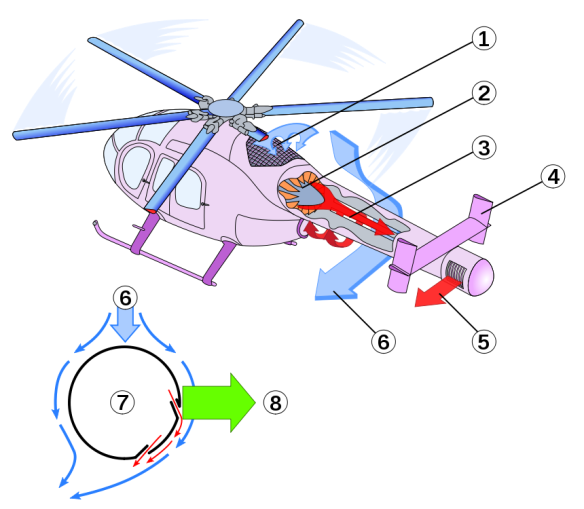1 Air intake 2 Variable pitch fan 3 Tail boom with Coandă Slots 4 Vertical stabilizers 5 Direct jet thruster 6 Downwash 7 Circulation control tailboom cross-section 8 Anti-torque lift
Diagram showing the movement of air through the NOTAR system.
One of the most radical innovations in helicopter design began in the mid-1940s. In 1944, James Weir of the Cierva Autogyro company in Britain produced the W-9 helicopter. The W-9 appeared much like other early helicopters, with a three-bladed main rotor and bubble canopy, but the tubular tailboom had no tailrotor. Instead exhaust gases ducted into the tailboom and ejected through nozzles replaced the antitorque rotor. The W-9 first flew in 1944, but it crashed in 1946 and was abandoned-but not before laying the foundation for the modern NOTAR (“No TailRotor” concept).
In 1962, Hughes Helicopters rejoined the U. S. Army investigations into rotors powered by pressure-jets. Hughes constructed the Model 385, designated XV-9 experimental helicopter by the Army. On November 5, 1964, the XV-9 made its first flight. The helicopter, fabricated from the nose of a Hughes 369, an H-34 landing gear, and components from other aircraft, was powered by two General Electric YT64 gas generators. Installed externally on pods, the generators produced hot exhaust gases that were ducted to pressure nozzles at the tips of the three main rotor blades, providing thrust to lift the machine.
In the late 1970s and early 1980s, Hughes pursued the idea of controlling a helicopter with pressure-jets but changed the focus to the antitorque system, initiating the NOTAR project. McDonnell- Douglas, and then Boeing, continued the program after acquisition of the Hughes company. Several aerodynamic engineers believed the NOTAR to be a more efficient and less vulnerable antitorque system than the traditional tailrotor. They replaced the existing Model 500 tailboom with a larger tubular tail section, from which pressurized air was ejected through vents installed at the end of the boom to counteract the torque created by the main rotor system. Although the military expressed little interest, Hughes continued to research the NOTAR thrust system and, on December 17, 1981, an OH-6 modified with the NOTAR boom took off on its maiden flight.
After McDonnell-Douglas obtained Hughes Aircraft, the company decided to offer the system on McDonnell-Douglas civil helicopters. In December 1989 the prototype MD 530N, essentially, a Model 530K with the NOTAR tailboom, made its first flight. After certification by the FAA, McDonnell-Douglas marketed several larger versions of the NOTAR design, the first being the MD 520 N, with a larger cabin and a five-bladed main rotor powered by a single Allison 250-C47M 800-horsepower engine. Successive NOTAR models introduced into the late 1990s included the 600N and 900N series of executive helicopters with luxurious club seating for six to eight passengers. The latest versions featured larger five- or sixbladed main rotors and options of twin engine packages such as two 629-horsepower Pratt & Whitney PW206B turboshafts. With the NOTAR designs Boeing claimed to produce some of the quietest and fastest executive helicopters on the market.
The mythology of Notar has grown, and continues to grow, due to the excellent public relations campaign that was conducted 25 years ago. Here is some factual info:
1) Notar works, is effective, flies well and is quieter and generally immune to tail strikes. People who fly them like them.
2) Notar has considerably more critical parts than a tail rotor. It has a tail rotor inside its tail cone, with all the tail rotor stuff, and it has a Coanda slot, and it has the rotating nozzle at the tail, and it has the sas and sometimes a rudder. It costs more, weighs more, has mor maintenance and more critical failure potential.
3) The Coanda slot has limited use as anti-torque. Only in very low wind does the main rotor wash fall squarely on the tail cone, allowing the Coanda magic to work. Every other time the Coanda effect is small, and Notar uses its tail tip thruster, which is fairly inefficient.
4) The power losses of the Notar are fairly large, relative to an open tail rotor, so the payload of a Notar is lower, or the installed power is higher.
5) Why fewer Notars? Less payload, more fuel flow in cruise,(but also quieter, less likely to have a tail strike.)
